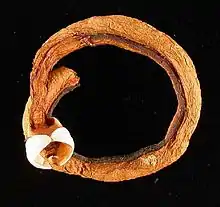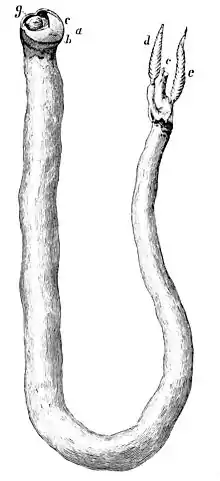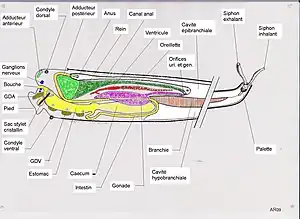Shipworm
The shipworms, also called Teredo worms or simply Teredo (from Ancient Greek τερηδών (terēdṓn) 'wood-worm', via Latin terēdō), are marine bivalve molluscs in the family Teredinidae, a group of saltwater clams with long, soft, naked bodies. They are notorious for boring into (and commonly eventually destroying) wood that is immersed in seawater, including such structures as wooden piers, docks, and ships; they drill passages by means of a pair of very small shells (“valves”) borne at one end, with which they rasp their way through. They are sometimes called "termites of the sea".[1] Carl Linnaeus assigned the common name Teredo to the best-known genus of shipworms in the 10th edition of his taxonomic magnum opus, Systema Naturæ (1758).
| Shipworm | |
|---|---|
 | |
| This dried specimen of Teredo navalis, and the calcareous tunnel that originally surrounded it and curled into a circle during preservation, were extracted from the wood of a ship. The two valves of the shell are the white structures at the anterior end; they are used to dig the tunnel in the wood. | |
| Scientific classification | |
| Domain: | Eukaryota |
| Kingdom: | Animalia |
| Phylum: | Mollusca |
| Class: | Bivalvia |
| Superorder: | Imparidentia |
| Order: | Myida |
| Superfamily: | Pholadoidea |
| Family: | Teredinidae Rafinesque, 1815 |
| Genera | |
|
See text | |
Characteristics

Removed from its burrow, the fully grown teredo ranges from several centimetres to about a metre in length, depending on the species. The body is cylindrical, slender, naked and superficially vermiform (worm-shaped). In spite of their slender, worm-like forms, shipworms possess the characteristic morphology of bivalves. The ctinidia lie mainly within the branchial siphon, through which the animal pumps the water that passes over the gills.
The two siphons are very long and protrude from the posterior end of the animal. Where they leave the end of the main part of the body, the siphons pass between a pair of calcareous plates called pallets. If the animal is alarmed, it withdraws the siphons and the pallets protectively block the opening of the tunnel.
The pallets are not to be confused with the two valves of the main shell, which are at the anterior end of the animal. Because they are the organs that the animal applies to boring its tunnel, they generally are located at the tunnel's end. They are borne on the slightly thickened, muscular anterior end of the cylindrical body and they are roughly triangular in shape and markedly concave on their interior surfaces. The outer surfaces are convex and in most species are deeply sculpted into sharp grinding surfaces with which the animals bore their way through the wood or similar medium in which they live and feed. The valves of shipworms are separated and the aperture of the mantle lies between them. The small "foot" (corresponding to the foot of a clam) can protrude through the aperture.
When shipworms bore into submerged wood, bacteria (Teredinibacter turnerae), in a special organ called the gland of Deshayes, digest the cellulose exposed in the fine particles created by the excavation.[2] The excavated burrow is usually lined with a calcareous tube. The valves of the shell of shipworms are small separate parts located at the anterior end of the worm, used for excavating the burrow.
Anatomy

Shipworm anatomy reveals the typical organs of a bivalve mollusk, although with dimensional or positional peculiarities due to the thinness and length of the occupied space. Furthermore, some structures find no equivalent in other bivalve groups.
- Gills are divided in two halves, the anterior one of small size, the posterior one much more developed. They are linked by the alimentary tract running on the side of the visceral mass.
- The heart-kidney system is tilted, bringing the kidneys in a dorsal position relative to the heart, whose atria find themselves behind the ventricle. Furthermore, the anterior and posterior aorta become respectively posterior and anterior.
- The anus opens at the end of a long anal tube.
- The digestive gland is divided into several parts, with separate orifices in the stomach.
- A vast caecum is linked to the stomach.
- The digestive tube bears a very peculiar structure, the gland of Deshayes, probably homologous to salivary glands,[3]which link to the oesophagus and stretch to the dorsal side of the posterior part of the gills.
- The orifice of the gallery bears pallets with their own musculature.
- The siphon retractor muscles are inserted on the calcareous covering of the gallery, and not on the shell's valves which are much further out.
- The anterior and posterior anterior muscles have an antagonistic action.
Normally, the shipworm's body fills the entire length of the gallery, but the anterior region can retract itself slightly with respect to the latter's extremity. Without the gills, the viscera only cover one-fourth of the total length and only their anterior part is partially covered by the shell.[4][5]
Taxonomy
Shipworms are marine animals in the phylum Mollusca, order Bivalvia, family Teredinidae. They were included in the now obsolete order Eulamellibranchiata,[6] in which many documents still place them.
Ruth Turner of Harvard University was the leading 20th century expert on the Teredinidae; she published a detailed monograph on the family, the 1966 volume "A Survey and Illustrated Catalogue of the Teredinidae" published by the Museum of Comparative Zoology. More recently, the endosymbionts that are found in the gills have been subject to study the bioconversion of cellulose for fuel energy research.[7]
Shipworm species comprise several genera, of which Teredo is the most commonly mentioned. The best known species is Teredo navalis. Historically, Teredo concentrations in the Caribbean Sea have been substantially higher than in most other salt water bodies.
Genera within the family Teridinidae include:[8]
- Bactronophorus Tapparone-Canefri, 1877
- Bankia Gray, 1842
- Dicyathifer Iredale, 1932
- Kuphus Guettard, 1770
- Lithoredo Shipway, Distel & Rosenberg, 2019
- Lyrodus Binney, 1870
- Nausitoria Wright, 1884
- Neoteredo Bartsch, 1920
- Nototeredo Bartsch, 1923
- Psiloteredo Bartsch, 1922
- Spathoteredo Moll, 1928
- Teredo Linnaeus, 1758
- Teredora Bartsch, 1921
- Teredothyra Bartsch, 1921
- Uperotus Guettard, 1770
- Zachsia Bulatoff & Rjabtschikoff, 1933
Species
The longest marine bivalve, Kuphus polythalamia, was found from a lagoon near Mindanao island in the southeastern part of the Philippines, which belongs to the same group of mussels and clams. The existence of huge mollusks was established for centuries and studied by the scientists, based on the shells they left behind that were the size of baseball bats (length 1.5 meters (5 ft.), diameter 6 cm (2.3 in.) ).[9][10] The bivalve is a rare creature that spends its life inside an elephant tusk-like hard shell made of calcium carbonate. It has a protective cap over its head which it reabsorbs to burrow into the mud for food. The case of the shipworm is not just the home of the black slimy worm. Instead, it acts as the primary source of nourishment in a non-traditional way. K. polythalamia sifts mud and sediment with its gills. Most shipworms are relatively smaller and feed on rotten wood. This shipworm instead relies on a beneficial symbiotic bacteria living in its gills. The bacteria use the hydrogen sulfide for energy to produce organic compounds that in turn feed the shipworms, similar to the process of photosynthesis used by green plants to convert the carbon dioxide in the air into simple carbon compounds. Scientists found that K. polythalamia cooperates with different bacteria than other shipworms, which could be the reason why it evolved from consuming rotten wood to living on hydrogen sulfide in the mud. The internal organs of the shipworm have shrunk from lack of use over the course of its evolution The scientists are planning to study the microbes found in the single gill of K. polythalamia to find a new possible antimicrobial substance
Habitat
The shipworm lives in waters with oceanic salinity. Accordingly, it is rare in the brackish Baltic Sea, where wooden shipwrecks are preserved for much longer than in the oceans.[11]
The range of various species has changed over time based on human activity. Many waters in developed countries that had been plagued by shipworms were cleared of them by pollution from the Industrial Revolution and the modern era; as environmental regulation led to cleaner waters, shipworms have returned.[12] Climate change has also changed the range of species; some once found only in warmer and more salty waters like the Caribbean have established habitats in the Mediterranean.[12]
Cultural impact
Shipworms greatly damage wooden hulls and marine piling, and have been the subject of much study to find methods to avoid their attacks.[12] Copper sheathing was used on wooden ships in the latter 18th century and afterwards, as a method of preventing damage by "teredo worms". The first historically documented use of copper sheathing was experiments held by the British Royal Navy with HMS Alarm, which was coppered in 1761 and thoroughly inspected after a two-year cruise. In a letter from the Navy Board to the Admiralty dated 31 August 1763 it was written "that so long as copper plates can be kept upon the bottom, the planks will be thereby entirely secured from the effects of the worm."
In the Netherlands the shipworm caused a crisis in the 18th century by attacking the timber that faced the sea dikes. After that the dikes had to be faced with stones. In 2009, Teredo have caused several minor collapses along the Hudson River waterfront in Hoboken, New Jersey, due to damage to underwater pilings.[13]

In the early 19th century, engineer Marc Brunel observed that the shipworm's valves simultaneously enabled it to tunnel through wood and protected it from being crushed by the swelling timber. With that idea, he designed the first tunnelling shield, a modular iron tunnelling framework which enabled workers to tunnel through the unstable riverbed beneath the Thames. The Thames Tunnel was the first successful large tunnel built under a navigable river.[12][14]
Henry David Thoreau's poem "Though All the Fates" pays homage to "New England's worm" which, in the poem, infests the hull of "[t]he vessel, though her masts be firm". In time, no matter what the ship carries or where she sails, the shipworm "her hulk shall bore,/[a]nd sink her in the Indian seas".[15] The hull of the ship wrecked by a whale, inspiring Moby Dick, had been weakened by shipworms.[12] In the Norse Saga of Erik the Red, Bjarni Herjólfsson, said to be the first European to discover the Americas,[16] had his ship drift into the Irish Sea where it was eaten up by shipworms. He allowed half the crew to escape in a smaller boat covered in seal tar, while he stayed behind to drown with his men.
Cuisine
.jpg.webp)
In Palawan and Aklan in the Philippines, the shipworm is called tamilok and is eaten as a delicacy. It is prepared as kinilaw—that is, raw (cleaned) but marinated with vinegar or lime juice, chopped chili peppers and onions, a process very similar to shrimp ceviche. The taste of the flesh has been compared to a wide variety of foods, from milk to oysters.[17] Similarly, the delicacy is harvested, sold, and eaten from those taken by local natives in the mangrove forests of West Papua, Indonesia and the central coastal peninsular regions of Thailand near Ko Phra Thong.
References
- Garcia, Sierra (2021-12-24). "How "Termites of the Sea" Have Shaped Maritime Technology". JSTOR Daily. Retrieved 2022-05-01.
- Distel, D. L.; Morrill, W.; MacLaren-Toussaint, N.; Franks, D.; Waterbury, J. (2002). "Teredinibacter turnerae gen. nov., sp. nov., a dinitrogen-fixing, cellulolytic, endosymbiotic gamma-proteobacterium isolated from the gills of wood-boring molluscs (Bivalvia: Teredinidae)". International Journal of Systematic and Evolutionary Microbiology. 52 (6): 2261–2269. doi:10.1099/ijs.0.02184-0. hdl:1912/110. ISSN 1466-5026.
- Morton, B., 1978. Feeding and digestion in shipworms. Oceanogr. Mar. Biol. Ann. Rev. 16 : 107-144.
- Sigerfoos, C.P., 1907. Natural history, organization, and late development of the Teredindaei, or ship-worms. Bureau of Fisheries Document N°639. 191-231.
- Turner R., 1966. A survey and illustrated catalogue of the Teredinae (Mollusca : Bivalvia). The Museum of Comparative Zoology, Harvard University, Cambridge, Mass. 02138, 18-45.
- Ponder, Winston F.; Lindberg, David R., eds. (2008). Phylogeny and Evolution of the Mollusca. University of California Press. ISBN 978-0-520-25092-5.
- Yang, JC; Madupu, R; Durkin, AS; Ekborg, NA; Pedamallu, CS; Hostetler, JB; Radune, D; Toms, BS; Henrissat, B; Coutinho, PM; Schwarz, S; Field, L; Trindade-Silva, AE; Soares, CA; Elshahawi, S; Hanora, A; Schmidt, EW; Haygood, MG; Posfai, J; Benner, J; Madinger, C; Nove, J; Anton, B; Chaudhary, K; Foster, J; Holman, A; Kumar, S; Lessard, PA; Luyten, YA; Slatko, B; Wood, N; Wu, B; Teplitski, M; Mougous, JD; Ward, N; Eisen, JA; Badger, JH; Distel, DL (Jul 1, 2009). "The complete genome of Teredinibacter turnerae T7901: an intracellular endosymbiont of marine wood-boring bivalves (shipworms)". PLOS ONE. 4 (7): e6085. Bibcode:2009PLoSO...4.6085Y. doi:10.1371/journal.pone.0006085. PMC 2699552. PMID 19568419.
- Bouchet, P. (2015). "Teredinidae Rafinesque, 1815". WoRMS. World Register of Marine Species. Retrieved 2015-02-14.
- "This Is a Giant Shipworm. You May Wish It Had Stayed In Its Tube. - T…". The New York Times. 2020-11-15. Archived from the original on 2020-11-15.
- Live example seen on 19 April 2017 on the BBC's website.
- "Historic shipwrecks could be preserved in the Antarctic". sciencenordic.com. Retrieved 2017-02-28.
- Gilman, Sarah (December 5, 2016). "How a Ship-Sinking Clam Conquered the Ocean". Smithsonian.
- "Pier-eating monsters: Termites of the sea causing piers to collapse". Hudson Reporter. Retrieved 2009-09-29.
- "Thames Tunnel Construction". Brunel Museum. Archived from the original on 2008-06-14. Retrieved 2008-08-31.
- Henry D. Thoreau, "Though All the Fates".
- "The Saga of Erik the Red - Icelandic Saga Database". Icelandic Saga Database. Retrieved 2017-07-04.
- Jodelen O. Ortiz (May 2, 2007). "Tamilok A Palawan: Delicacy". Archived from the original on April 17, 2009. Retrieved 2009-04-30.
Further reading
- Borges, L. M. S., et al. (2014). Diversity, environmental requirements, and biogeography of bivalve wood-borers (Teredinidae) in European coastal waters. Frontiers in Zoology 11:13.
- Powell A. W. B., New Zealand Mollusca, William Collins Publishers Ltd, Auckland, New Zealand 1979 ISBN 0-00-216906-1
External links
 Texts on Wikisource:
Texts on Wikisource:
- "Ship-worm". New International Encyclopedia. 1905.
- Baumhauer, Eduard Hendrik von (September 1878). "The Teredo and its Depredations II". Popular Science Monthly. Vol. 13.
- Baumhauer, Eduard Hendrik von (August 1878). "The Teredo and its Depredations I". Popular Science Monthly. Vol. 13.
- "The Borers of the Sea". Popular Science Monthly. Vol. 3. May 1873.